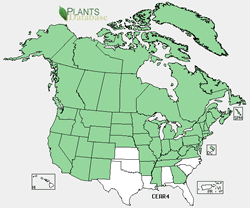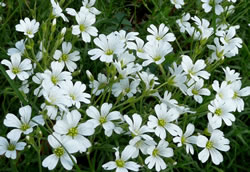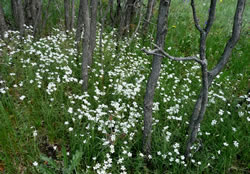Plant of the Week
 Range map of Cerastium arvense. States are colored green where the species may be found.
Range map of Cerastium arvense. States are colored green where the species may be found.
 Close-up of field chickweed flowers taken in a mountain meadow on the San Juan National Forest south of Pagosa Springs, Colorado. Photo by Charlie McDonald.
Close-up of field chickweed flowers taken in a mountain meadow on the San Juan National Forest south of Pagosa Springs, Colorado. Photo by Charlie McDonald.
 A patch of field chickweed growing in a small thicket of Gambel oak. These plants will finish flowering long before the oaks start to leaf out. Photo by Charlie McDonald.
A patch of field chickweed growing in a small thicket of Gambel oak. These plants will finish flowering long before the oaks start to leaf out. Photo by Charlie McDonald.
Field Chickweed (Cerastium arvense)
By Charlie McDonald
Field chickweed (Cerastium arvense) is in the pink family (Caryophyllaceae), which is a group of about 3,000 species worldwide, with many of them being cultivated ornamentals. The carnation (Dianthus caryophyllus) is perhaps the best known member of the pink family.
Field chickweed is a spring-blooming matted or clumped perennial herb that pops up in a variety of open sunny habitats at elevations from sea level to over 12,000 feet. It grows throughout North America, but is infrequent in the Southeast. Plants in the western U.S. have somewhat larger flowers than those in the East.
When you say chickweed, most people think of common chickweed (Stellaria media) or common mouse-ear chickweed (Cerastium fontanum), which were introduced from Europe and now grow in all 50 states. These plants have inconspicuous flowers and are considered weeds by anyone wanting a well manicured lawn. Conversely, field chickweed is a pretty little plant that does not deserve the stigma of being associated with its weedy relatives. It is a native North American plant, grows only in wild habitats, and makes a nice addition to the spring wildflower display throughout much of North America.

